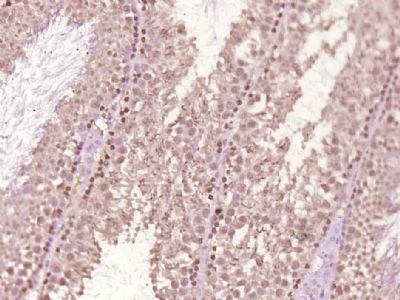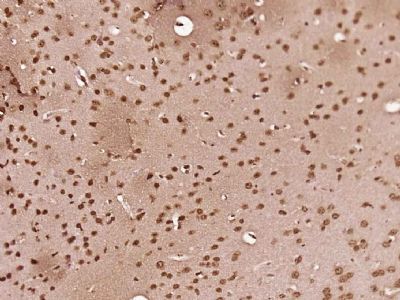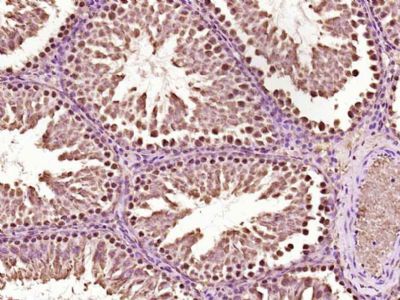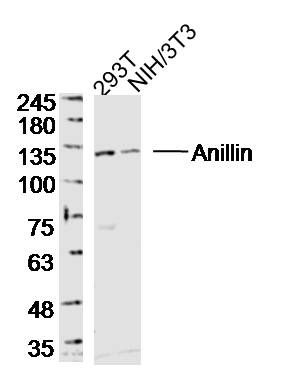Anillin Polyclonal Antibody
Purified Rabbit Polyclonal Antibody (Pab)
- SPECIFICATION
- CITATIONS
- PROTOCOLS
- BACKGROUND

Application
| WB, IHC-P, IHC-F, IF |
|---|---|
| Primary Accession | Q9NQW6 |
| Reactivity | Rat, Dog |
| Host | Rabbit |
| Clonality | Polyclonal |
| Calculated MW | 124 KDa |
| Physical State | Liquid |
| Immunogen | KLH conjugated synthetic peptide derived from human Anillin |
| Epitope Specificity | 621-720/1124 |
| Isotype | IgG |
| Purity | affinity purified by Protein A |
| Buffer | Preservative: 0.02% Proclin300, Constituents: 1% BSA, 0.01M PBS, pH7.4. |
| SUBCELLULAR LOCATION | Nucleus. Cytoplasm, cytoskeleton. Cytoplasm, cell cortex. Note=Mainly found in the nucleus during interphase. Colocalizes with cortical F-actin upon nuclear envelope breakdown in mitosis and subsequently concentrates in the area of the prospective contractile ring in anaphase. This pattern persists until telophase, when the protein becomes concentrated in the midbody. |
| SIMILARITY | Contains 1 PH domain. |
| SUBUNIT | Interacts with F-actin. Interacts with CD2AP. May interact with RHOA. Interacts with FZR1/CDH1 during mitotic exit. |
| Post-translational modifications | Phosphorylated during mitosis. Ubiquitinated, and this requires FZR1/CDH1. |
| Important Note | This product as supplied is intended for research use only, not for use in human, therapeutic or diagnostic applications. |
| Background Descriptions | Anillin, also known as scraps homolog, is an evolutionarily conserved Actin- binding protein required for cytokinesis that was first identified in Drosophila melanogaster. Anillin is a ubiquitously expressed protein with highest expression levels in the central nervous system. It is predominantly found in the nucleus and it localizes to the cleavage furrow during cytokinesis, forming a ring with the help of Rac GTPase. During cytokinesis, Anillin interacts with CD2AP and functions to concentrate Rho A and maintain the localization of active Myosin. In Anillin knockout cells the cleavage furrow fails to complete ingression. Anillin expression levels fluctuate with the cell cycle, peaking in mitosis. Before the cell exits into G1, Anillin associates with E-cadherin and is ubiquitinated by the anaphase-promoting complex/cyclosome (APC/C). APC/C recognizes the D-box domain at the N-terminal region of Anillin. Anillin is commonly overexpressed in tumors and may serve as a potential biomarker.Anillin is required for cytokinesis. It is essential for the structural integrity of the cleavage furrow and for completion of cleavage furrow ingression. |
| Gene ID | 54443 |
|---|---|
| Other Names | Anillin, ANLN |
| Target/Specificity | Ubiquitously expressed. Present at highest levels in the brain, at high levels in the placenta and testis, at intermediate levels in the intestine, ovary, skeletal muscle and thymus and at lower levels in heart, kidney, liver, lung, pancreas, prostate and spleen. Overexpressed in many tumor types including breast, colorectal, endometrial, hepatic, kidney, lung, ovarian and pancreatic tumors. |
| Dilution | WB=1:500-2000,IHC-P=1:100-500,IHC-F=1:100-500,IF=1:100-500 |
| Format | 0.01M TBS(pH7.4), 0.09% (W/V) sodium azide and 50% Glyce |
| Storage | Store at -20 ℃ for one year. Avoid repeated freeze/thaw cycles. When reconstituted in sterile pH 7.4 0.01M PBS or diluent of antibody the antibody is stable for at least two weeks at 2-4 ℃. |
| Name | ANLN |
|---|---|
| Function | Required for cytokinesis (PubMed:16040610). Essential for the structural integrity of the cleavage furrow and for completion of cleavage furrow ingression. Plays a role in bleb assembly during metaphase and anaphase of mitosis (PubMed:23870127). May play a significant role in podocyte cell migration (PubMed:24676636). |
| Cellular Location | Nucleus. Cytoplasm, cytoskeleton. Cytoplasm, cell cortex. Cell projection, bleb. Note=Mainly found in the nucleus during interphase. Colocalizes with cortical F-actin upon nuclear envelope breakdown in mitosis and subsequently concentrates in the area of the prospective contractile ring in anaphase. This pattern persists until telophase, when the protein becomes concentrated in the midbody |
| Tissue Location | Ubiquitously expressed. Present at highest levels in the brain, at high levels in the placenta and testis, at intermediate levels in the intestine, ovary, skeletal muscle and thymus and at lower levels in heart, kidney, liver, lung, pancreas, prostate and spleen. In the kidney, it is widely expressed in tubules, but sparsely expressed in the glomerulus (PubMed:24676636). Expression is significantly increased in renal biopsy specimens from idiopathic FSGS (PubMed:24676636). Overexpressed in many tumor types including breast, colorectal, endometrial, hepatic, kidney, lung, ovarian and pancreatic tumors. |

Thousands of laboratories across the world have published research that depended on the performance of antibodies from Abcepta to advance their research. Check out links to articles that cite our products in major peer-reviewed journals, organized by research category.
info@abcepta.com, and receive a free "I Love Antibodies" mug.
Provided below are standard protocols that you may find useful for product applications.
If you have used an Abcepta product and would like to share how it has performed, please click on the "Submit Review" button and provide the requested information. Our staff will examine and post your review and contact you if needed.
If you have any additional inquiries please email technical services at tech@abcepta.com.













 Foundational characteristics of cancer include proliferation, angiogenesis, migration, evasion of apoptosis, and cellular immortality. Find key markers for these cellular processes and antibodies to detect them.
Foundational characteristics of cancer include proliferation, angiogenesis, migration, evasion of apoptosis, and cellular immortality. Find key markers for these cellular processes and antibodies to detect them. The SUMOplot™ Analysis Program predicts and scores sumoylation sites in your protein. SUMOylation is a post-translational modification involved in various cellular processes, such as nuclear-cytosolic transport, transcriptional regulation, apoptosis, protein stability, response to stress, and progression through the cell cycle.
The SUMOplot™ Analysis Program predicts and scores sumoylation sites in your protein. SUMOylation is a post-translational modification involved in various cellular processes, such as nuclear-cytosolic transport, transcriptional regulation, apoptosis, protein stability, response to stress, and progression through the cell cycle. The Autophagy Receptor Motif Plotter predicts and scores autophagy receptor binding sites in your protein. Identifying proteins connected to this pathway is critical to understanding the role of autophagy in physiological as well as pathological processes such as development, differentiation, neurodegenerative diseases, stress, infection, and cancer.
The Autophagy Receptor Motif Plotter predicts and scores autophagy receptor binding sites in your protein. Identifying proteins connected to this pathway is critical to understanding the role of autophagy in physiological as well as pathological processes such as development, differentiation, neurodegenerative diseases, stress, infection, and cancer.





